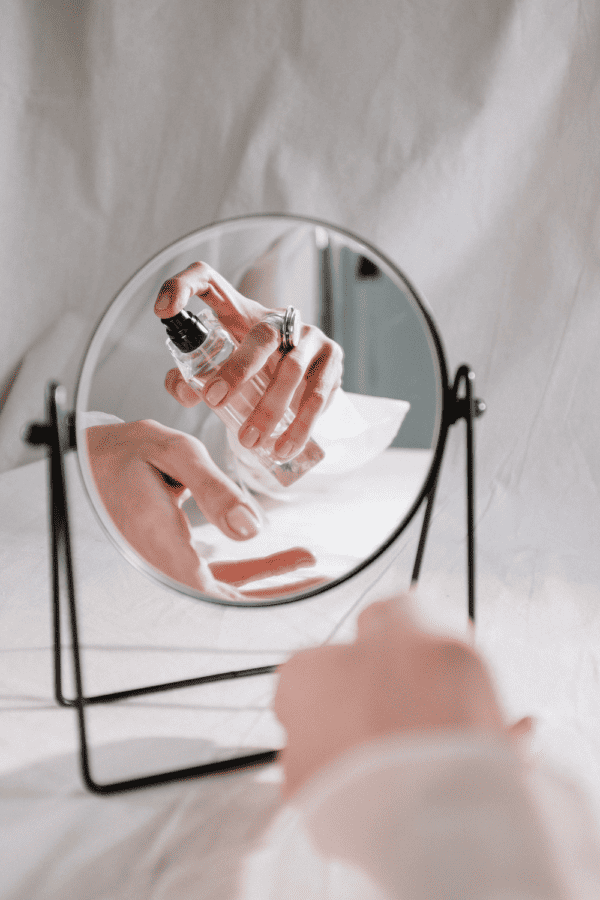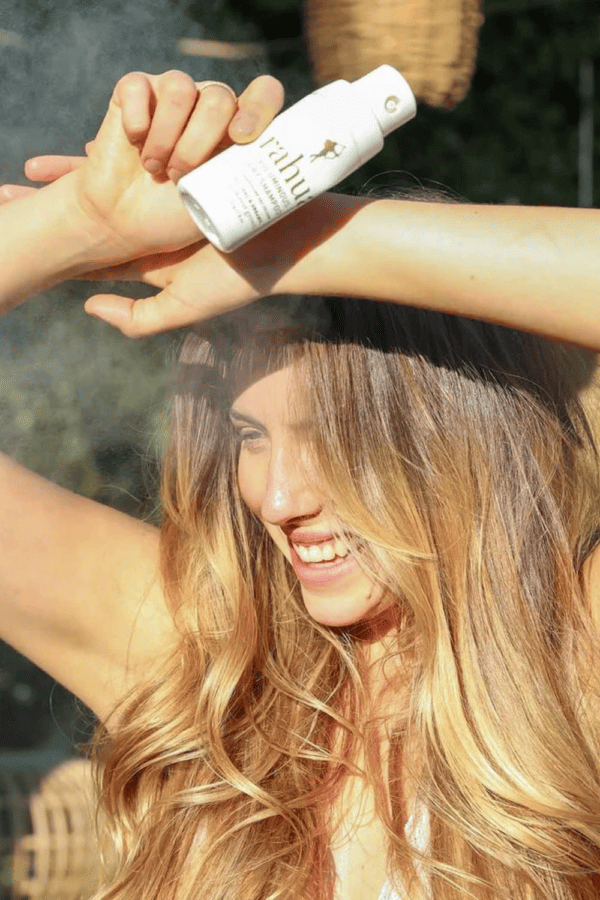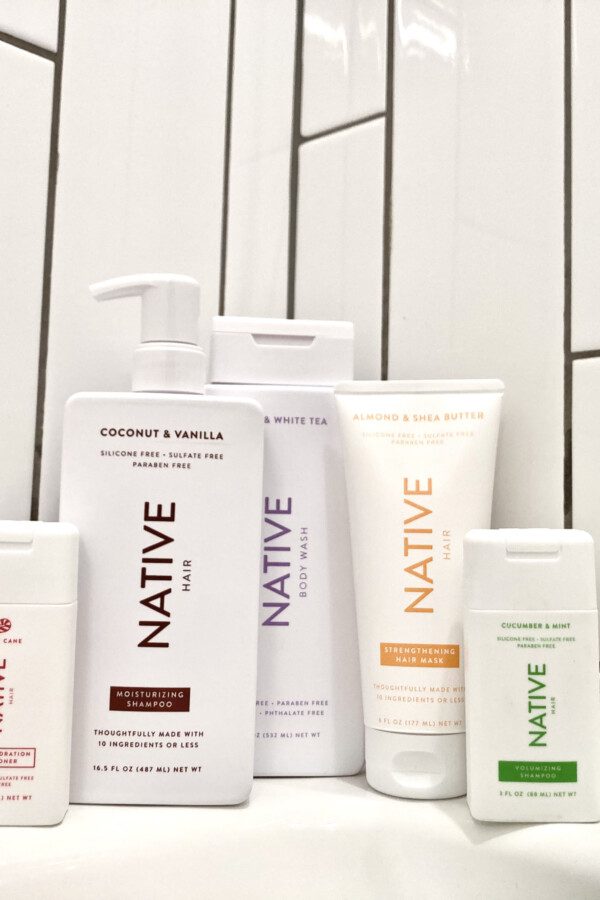Written by Emmanuella Ogbonna
Many people (especially millennials and Gen Z!) are shifting away from conventional period pads and disposable tampons and towards reusable alternatives like period underwear and menstrual cups.
This shift may be due to in part to increased interest in sustainability, or perhaps people are simply looking for more options that better fit their bodies, lifestyles, budgets, and preferences.
Whatever the reason, I think menstrual cups and discs are here to stay! So in this article, we’re giving you the rundown on some of the best menstrual cups on the market and some considerations to keep in mind when choosing which option is best for you.
Table of Contents
- Benefits of Menstrual Cups & Discs
- Cons of Menstrual Cups
- Materials to Look for in a Non-Toxic Period Cup
- What About an Organic Menstrual Cup?
- What’s the Difference Between Menstrual Cups and Discs?
- Choosing the Right Cup for You
- Our Picks for the Best Non-Toxic Menstrual Cup Brands
- How to Clean & Care for Your Menstrual Cup
- FAQs
This article contains affiliate links, which means we may earn a commission if you decide to make a purchase.
If you haven’t used a menstrual cup in the past, you may want to consider the pros and cons to using a cup/disc compared to other period products. First, let’s talk about the benefits:
Benefits of Menstrual Cups & Discs
Sustainability: Menstrual cups are reusable, making them more eco-friendly than pads and tampons. One menstrual cup can last up to 10 years if used correctly and handled with care. Because they can be used for a longer time, they can obviously help reduce quite a bit of waste, especially compared to disposable tampons and pads.
Cost saving: Most cups cost between $20 and $50. Because they last a long time, you are saving a lot of money compared to getting disposable pads and tampons every month. Plus, menstrual cups are now HSA/FSA eligible as well!
Less risk of infection/TSS: There is a lower risk of infection and toxic shock syndrome (TSS) when using menstrual cups compared to using pads and tampons.
Convenience: You can use a cup for as long as 12 hours before needing to discard the blood and clean it (you shouldn’t use it longer than 12 hours though). This means you do not have to worry constantly about bringing an extra pad. Obviously, the actual amount of time you can leave a cup in will vary depending on your flow and the size of the cup, so be sure to check the directions and suggestions on the specific product you’re using.
Period sex: While you can’t have sex while wearing a menstrual cup, you can have sex while wearing a disc. (Note, however, that it’s not meant to be a contraceptive or to prevent STDs.)
Cons of Menstrual Cups
There are also some downsides to menstrual cups and discs, including:
- There is a learning curve and they can be difficult to insert and remove at first. (Many of the brands below offer great options for beginners.)
- They can be messy, especially until you learn how to wear, remove, and clean them properly.
- Some people may find it uncomfortable.
- It might take a while to find the perfect fit for your body. You may have to try out several brands/shapes until you find your favorite.
- There is a risk of leakage. If you’re a new menstrual cup user, are having a heavier flow day, or are doing heavy exercise, you may need to use a backup, like a panty liner.
Materials to Look for in a Non-Toxic Period Cup
One of the other pros of using a menstrual cup or disc is that it’s actually very easy to find a non-toxic option. This is not the case for period underwear, which have been in the headlines over the past couple of years because of toxic PFAS contamination.
Similarly, many disposable cotton pads and tampons can contain things like dioxins and added fragrances, which can also be toxic.
Menstrual cups can be made of silicone, rubber, or thermoplastic elastomers (which is plastic). However, the safest material for menstrual cups is 100% medical-grade silicone. Cups made of 100% medical-grade silicone are free from plastic fillers, BPA and other bisphenols, as well as latex.
The good news is that most of the cups on the market use 100% medical grade silicone, so it’s really not difficult to find a safe option! All of our recommended brands below use 100% medical grade silicone.
The only other ingredient to consider when you’re shopping is the dye used to make colored menstrual cups. Most reputable brands use colorants that are also medical grade and that are relatively inert inside the silicone, meaning they won’t leach. That being said, it’s not always clear what exactly is used to color the silicone. So while this isn’t a big concern for most people, we have indicated which of the brands below offer clear options if you’d rather skip the dyes.
Note that there are a few menstrual cup brands that use thermoplastic elastomer (TPE) instead of silicone. Since this is a type of plastic, we don’t recommend it.
Also, one other quick note on the ingredient front. Many of the brands below also carry cleansers as well as other personal care products of various kinds. Although most of these brands are eco-conscious in their overall approach, we have not vetted all of each brand’s products for ingredients. We do plan to do that in the near future! But in the meantime, we can recommend using a safe and effective all-purpose cleanser such as Branch Basics to clean your period cup.
What About an Organic Menstrual Cup?
Organic menstrual cups don’t actually exist because organic silicone doesn’t exist. In order for something to be considered “organic,” it generally means that it is grown an processed without the use of synthetic pesticides or fertilizers. But the main component of silicone is silica, which is a mineral. It is not grown, but rather sourced from what already exists in the earth. Therefore, the “organic” label is irrelevant when it comes to silicone.
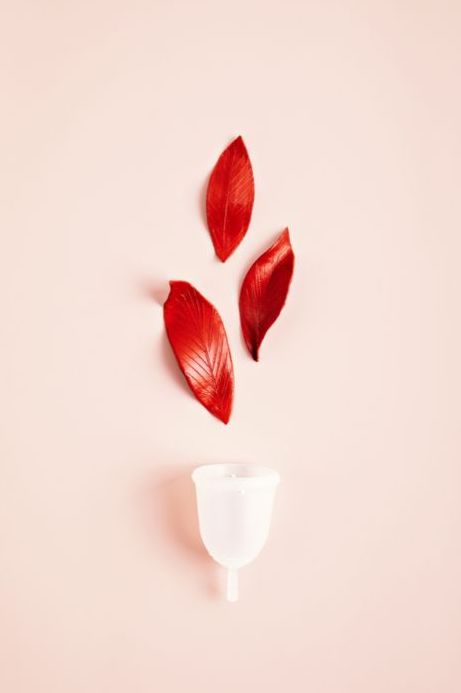
What’s the Difference Between Menstrual Cups and Discs?
Period cups and discs are both reusable, made out of silicone, and function in similar ways. Although they have a few differences, the main difference is their placement. Cups are placed further down in the vagina, while discs are placed higher up, behind the pubic bone. This allows you to have sex while wearing a disc, which is something you can’t do with a cup.
Here’s a table summarizing their differences:
| Cup | Disc | |
|---|---|---|
| Reusable | Yes | Yes |
| Worn Internally | Yes | Yes |
| Lifetime | Up to 10 years | Up to 10 years |
| Low-Odor | Yes, compared to pads & tampons | Yes, compared to pads & tampons |
| Non-Toxic | Yes, just look for 100% medical-grade silicone | Yes, just look for 100% medical-grade silicone |
| Shape | Generally more of a bell shape with a stem at the bottom | Flatter and rounder than cups |
| Placement | Placed lower in the vagina | Placed higher up, tucked behind the pubic bone |
| Removal | Stem or grip rings at the base | Discs require you to hook a finger under the rim or gently pull on the edge of the pouch to remove |
| Period Sex | No | Yes |
| Auto-Dumping | No | Yes |
Discs tend to be a little bit harder to use, so if you’re new to period cups or discs, it’s probably going to be easier to start with a cup and then “graduate” to a disc after you get the hang of things.
Choosing the Right Cup for You
The first thing to keep in mind when choosing a menstrual cup is that there is no universally “best” cup… It’s about you and your specific needs and preferences. Do you feel comfortable when wearing it? Does it fit? Do you find it easy to insert or remove?
That said, here are some things to consider when choosing the right menstrual cup for you.
1. The size
Menstrual cups come in different sizes. Some brands have options ranging from small to extra large; others may have more limited options. You can look at their size guide and consider your body and history. For example, if you have given birth, you might need a larger cup than someone who hasn’t. If you are in doubt about the size that would be right for your vagina, you can talk to your gynecologist. Many of the brands below also offer short and easy quizzes that can help you choose as well.
2. Volume
Just like with size, menstrual cups and discs can hold different volumes of blood. You have to consider your type of flow before choosing a menstrual cup. Many people choose to keep a couple different sizes that they can switch out based on if they’re having a heavier or lighter flow day.
3. Cervix height
Everyone’s body is different! Some people have low cervixes, while others have higher cervixes. So you have to choose a cup suitable for your cervix to reduce discomfort and leakage. Check the details on the product page for recommendations.
4. The shape
Cups and discs come in different shapes: round, v-shaped, bell-shaped, and asymmetrical. Bell-shaped cups are more common. Round-shaped cups are a good option for women with low cervixes. Asymmetrical cups are designed to take the shape of your vaginal canal. Think about the shapes and how it feeds to your needs. You may have to try out different options until you find what works best for you.
5. Firmness and flexibility
Menstrual cups come in different degrees of firmness. There are soft and firmer cups, depending on your preference. Some brands like Saalt offer a couple of different firmness options for their cups.
6. Budget
Your budget may also decide what cup you should go for, but there’s honestly not a huge difference in the price range. Most cups go for somewhere between $20 and $50.
Our Picks for the Best Non-Toxic Menstrual Cup Brands
Now let’s get to our favorite brands for period cups and discs. Note that ALL of the below options are made out of 100% medical grade silicone and are FSA/HSA eligible.
Saalt

Price: $29-$33
Size: Saalt Cup (Regular, Small); Soft Cup (Regular, Small); Teen Cup (one size); Disc (Regular, Small)
Made in: USA
Saalt has several options, with a quiz to help you choose the best option for you.
Their standard Saalt Cup has a unique bulb shape and a double seal with a flexible stem, making opening the cup and insertion easy.
All of their options can technically be used by beginners, but the Soft Cup and Teen Cup are made with extra care for beginners, people with a low cervix, those who have not given birth, and/or light-flow days. They’re also great options if you have a sensitive bladder or find a firmer cup uncomfortable.
That being said, soft silicone has its downside—namely that it makes it harder to create a firm seal, which might lead to leakage. Just something to keep in mind as you choose which menstrual products are best for you.
The Saalt Disc doesn’t rely on suction to seal and positions behind your pubic bone, making it ideal for those with bladder sensitivities or a weak pelvic floor. It includes a custom finger notch that makes removal easy.
Saalt does not have any clear options, but they ensure customers that the pigment itself is also medical-grade silicone. They also say that they actually do third-party testing to make sure that nothing leaches out of the cups or discs.
It’s also worth noting that Saalt‘s 2023 test results on Leah Segedie’s PFAS period underwear investigation came back as non-detect, which means they are basically PFAS-free. She had actually detected PFAS in Saalt’s period underwear in a prior year’s test, so good on them for fixing this problem. Saalt also says that they do their own testing to make sure there aren’t any PFAS as well.
Saalt also has a Replacement Guarantee: if you don’t like it, they will replace it with a different product or give you a refund.
All of their cups and discs can be used for up to 10 years, too!
Cora

Price: $30 – $46
Size/Volume: The Easy-Does-It Cup comes in Size 1 (22 mL; light to moderate flow) and Size 2 (28mL; moderate to heavy). The Perfect Fit Disc and the Soft Fit Disc come in 65mm diameter size (47.5ml).
Made in: USA
The Cora Easy-Does-It cup is hands down one of the best menstrual cups for beginners because of its smart design. The cup is slightly flattened at the side, giving you a place to put your finger when folding the cup for insertion. It also has a narrow textured base that makes removal easier. The discs have a little notch on the side that make insertion and removal easier. All options use suction to prevent leakage and keep the cup in position as you perform your daily activities.
Like the other non-toxic menstrual cups on this list, both the cups and the discs are made of 100% medical grade silicone.
The Cora menstrual cup comes in two sizes, depending on the intensity of your flow. For women with light to moderate flow and/or those who are new to menstrual cups, the size 1 menstrual cup should serve. Those with heavier flows should go for the size 2. Also, women who have given birth should use size 2 cups instead.
They also offer two different discs: the Perfect Fit Disc and the Soft Fit Disc. The Perfect Fit option has a firmer ridge, which works for most bodies and is great for activity and exercise. The Soft Fit Disc is made from squishier silicone and has an extra soft rim, which is ideal for those with vaginal or bladder sensitivities.
They do have clear options. The colored versions contain cobalt titanate and/or black iron oxide (which is a medical grade silicone colorant).
All of Cora’s cups and discs can be used for up to 10 years.
P.S. We don’t necessarily recommend Cora’s pads & tampons. You can read more about why here.
Lunette
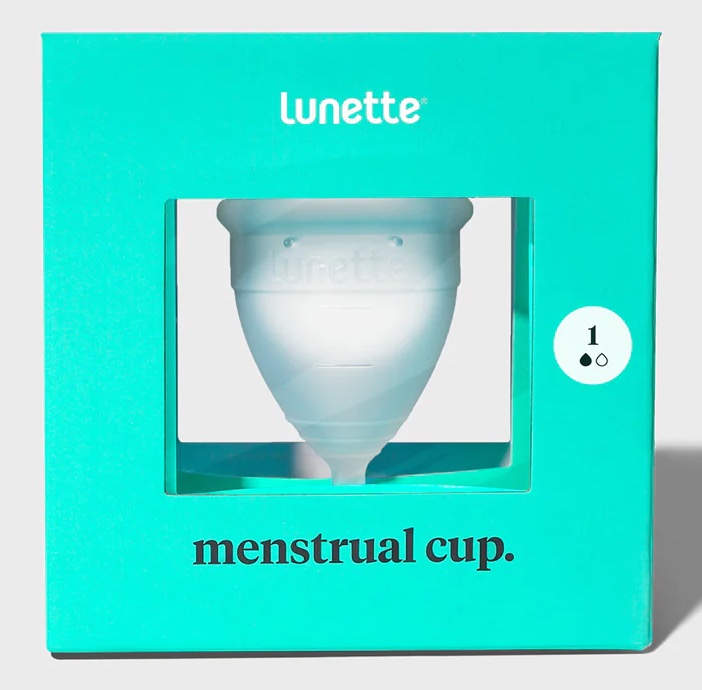
Price: $39.99
Size/Volume: 1 (light to moderate flow; 25mL), 2 (moderate to heavy flow; 30mL)
Made in: Finland (where the company is based)
The reusable menstrual cup from Lunette is also made from 100% medical grade silicone and has a soft, bendable, textured rim that makes insertion easy. The stem is also somewhat flattened and has ridges, which makes it grippable and easy to remove.
It comes in two different sizes and six different colors, including a clear one. Size 1 is suitable for people with light to moderate flow and low-sitting cervixes, as well as menstrual cup beginners.
Size 2 is designed for those with moderate to heavy flows and high cervixes. Size 1 is made from softer silicone than Size 2, so if you are looking for a firmer option, then Size 2 might be ideal.
The holes in the Lunette menstrual cups are also large, which makes washing and cleaning the cup easier, especially when there are residues.
Voxapod

Price: $29
Size/Volume: Small (24.7mL), Medium (37mL)
Made in: USA
If you have a heavy flow and want to stay active during your period, the Voxapod menstrual pod is a good option. It can hold up to 37mL of fluid, which is more than most other menstrual cups. That means you can go longer between changes.
The best feature of the Voxapod is that it’s designed to form to fit your unique body shape to be more comfortable.
The stem is also very flexible and easily trimmable; if you don’t like the height, then you can adjust it to the perfect fit without much hassle.
Like many of the other best menstrual cup brands, the Voxapod comes in two sizes: small and medium. The small size is designed for people with light to normal flow, and the medium is for people with heavy flow. The medium size is also ideal for people with sensitive bladder or weaker pelvic floor. If you’re not sure which one to get, they offer a Cup Quiz to help you figure it out.
They’re available in clear and gray options.
They also have a collapsible, portable cup cleaner, which is super convenient for cleaning your cup when you’re at work or on the go.
INTIMINA
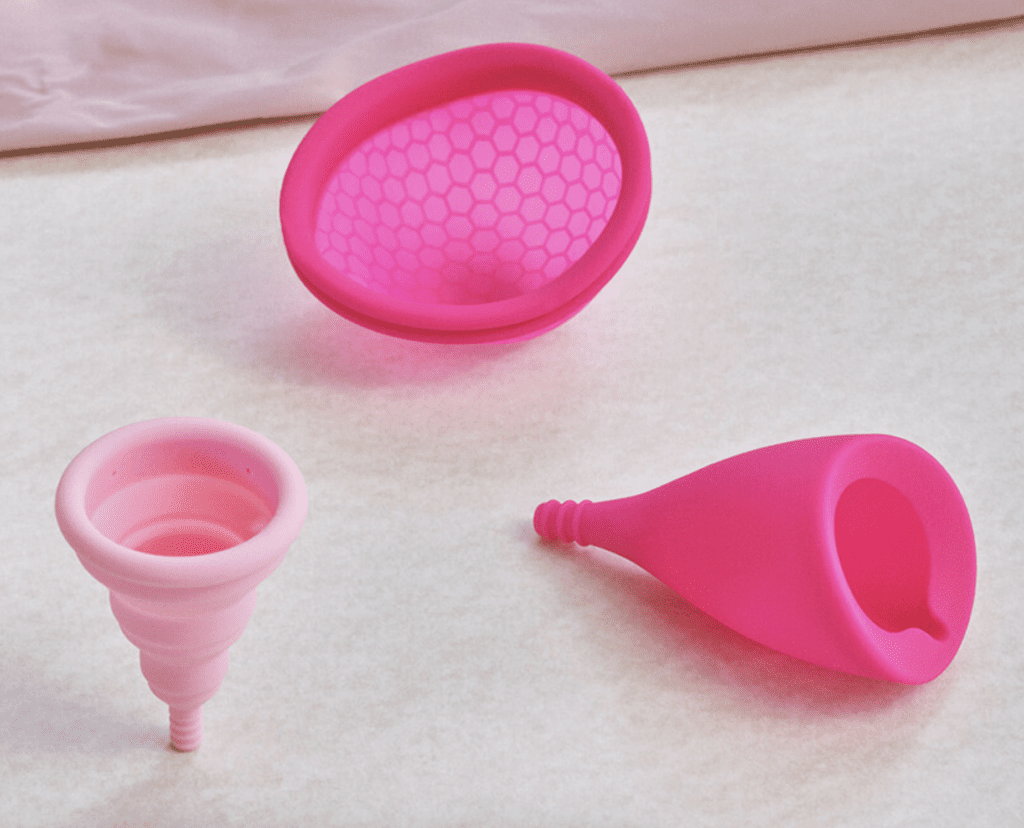
Price: $21-$45
Size: Lily Cup (Size A and Size B), Lily Cup One (just one size), Lily Cup Compact (Sizes A and B), Ziggy Cup (disc; Size A and B)
Made in: China
Intimina offers more options than many of the other reusable cup brands. To help you understand which cup is probably right for you, they have a simple quiz that will give you a recommendation based on a few questions.
The Lily Cup actually has a different shape compared to most other period cups, and it’s a great option for teenagers or new menstrual cup users. It’s a really comfortable cup, made of ultra-soft, medical-grade silicone, which makes folding and insertion easier. It comes in two sizes, but both are suitable for a range of flows. They also recommend this one for those with a higher cervix, as it has one of the longest stems on the market.
Its slanted design not only makes removal and insertion easier but also creates a better seal that helps minimize leakage. It also comes with a no-spill rim that helps prevent leakage even further.
The Lily Cup One is also a good option for beginners, as it has an extra-firm rim that makes opening and sealing easy, and a loop at the bottom instead of a stem. Unlike the standard Lily Cup, this one folds flat to fit in a convenient protective case! It also only comes in one size, which provides up to eight hours of protection.
Next up is the Lily Cup Compact, which is exactly what it sounds like: compact! It folds up into a carrying case just like the Lily Cup does, but this one is even smaller. So it’s great for lighter days and exercising. This one comes in two sizes, A and B.
Lastly, INTIMINA has a disc as well, which they call the Ziggy Cup. It comes in two sizes and has a ribbed tab for slip-free removal.
These are also all made out of 100% medical grade silicone. They all come in different shades of pink and they do not have any clear/undyed options.
nixit
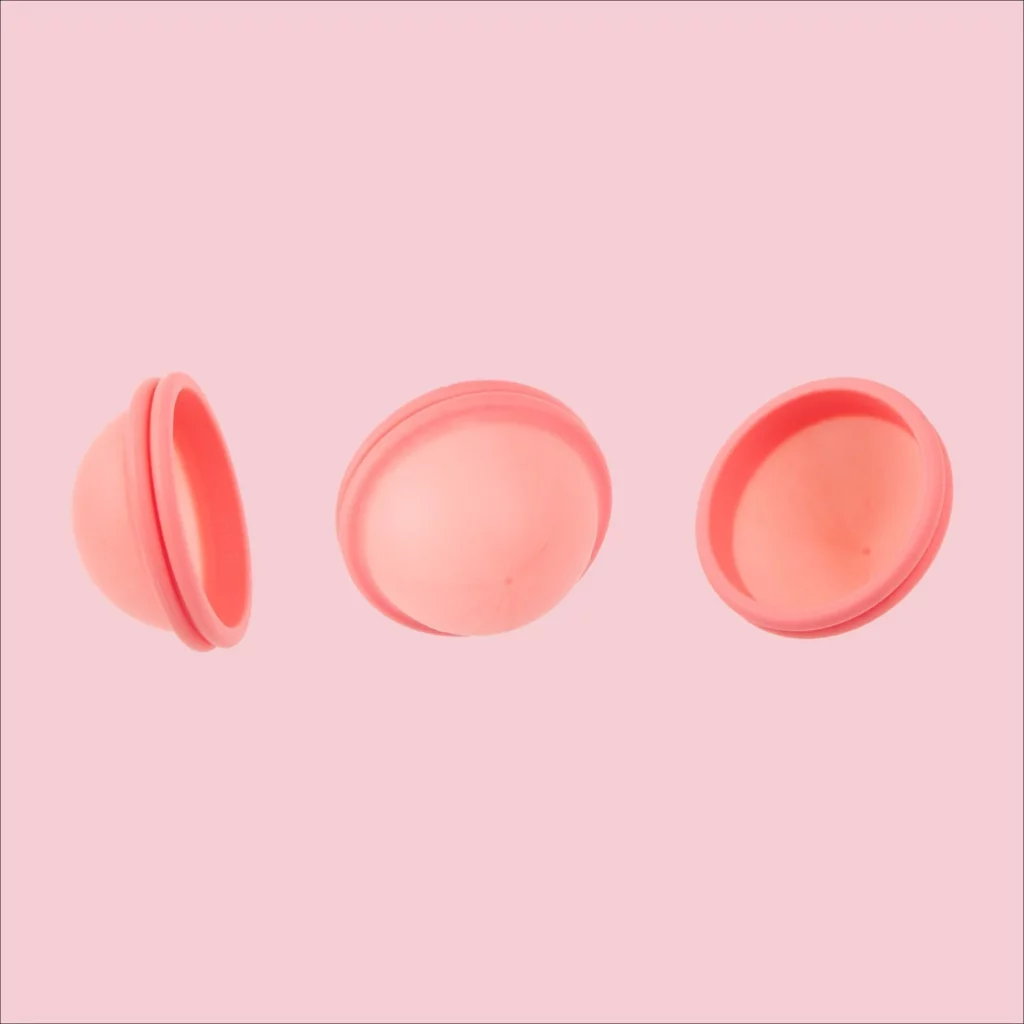
Price: $42
Size: Regular (70mL)
Made in: Canada
The nixit cup is a little bit confusing because it’s actually a disc. It’s made from ultra-soft silicone and has a one-size-fits-all shape. “No confusing sizes, no awkward folds” is how they describe it.
The nixit menstrual cup has a double rim, which reduces leakage. There are no stems, making this a good option for you if you find stems poking a little annoying.
The best part of the Nixit cup is how much volume it can hold. The Nixit menstrual cup can hold up to 70 ml of liquid, which is more than most menstrual cups can hold. So it is great for travel or when you have long, busy days at work where you might not get a break to clean or change your cup.
The Nixit cup is also suction free; it just fits into your body naturally, which makes removal a little more comfortable.
One downside to the Nixit Cup is its price. This cup is a little more pricey compared to other menstrual cups. It also comes in only one size, so if it doesn’t fit, then you may have to switch to a different brand.
They only offer colored options.
Lena

Price: $30
Size: Lena Cup (Small 25 mL, Large 30 mL); Sensitive Cup (Small 25 mL, Large 30 mL)
Volume: Size A (28mL), Size B (32mL)
Made in: California, USA
The Lena Cup has a bell shape and comes in two sizes. The small is ideal for all users regardless of physique, activity level, and reproductive history. The large is usually more suitable for more experienced menstrual cup users and/or those who have given birth before or have a heavier flow.
One of the smallest cups on the market, the Sensitive Cup is made especially for users with more sensitive anatomies or with sensitive bladders. It can also help provide a little bit of relief from period cramps on those painful days. (Some people may even want to have two different cups on hand, using the Sensitive one on some days and the Regular one on others.)
They have both colored and clear/undyed options.
Pixie
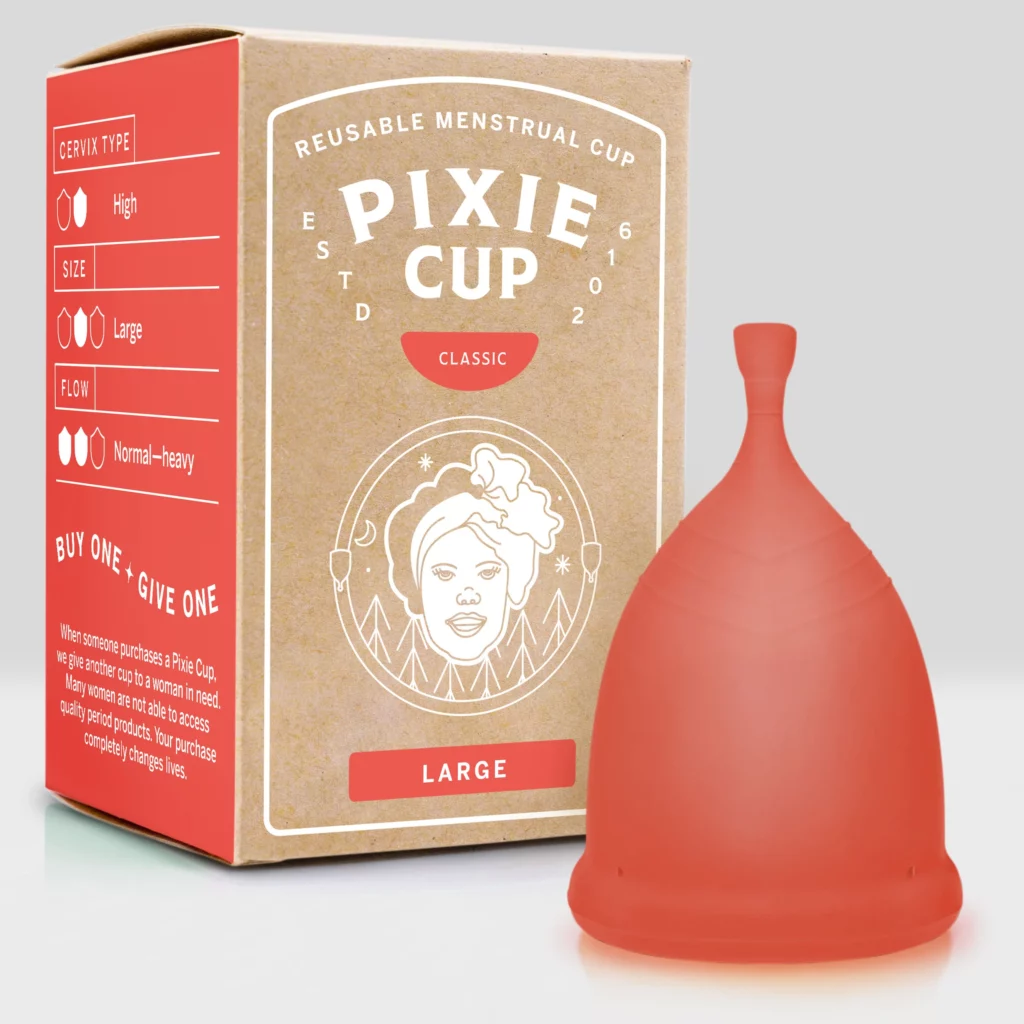
Price: $20-$25
Size: Classic Cup (XS, S, L, XL); Soft Cup (Small, Large) Disc (Small, Large)
Made in: China
Most of the best menstrual cup brands offer two or three size options at the most. But Pixie’s Classic Cup actually offers four different sizes! Right on the size of the box, they have symbols that make it easy to decide what’s best for you based on cervix type, size, and flow. There are options for everyone, including people with both high and low cervixes, beginners, and reproductive history.
This menstrual cup is also very affordable compared with other menstrual cups on this list. So if you are looking for an affordable yet comfortable menstrual cup, then Pixie might be a good option.
In addition to being eco-friendly and low-waste like the other reusable cup brands, they have extra initiatives as well. For example, for every cup purchased, they donate a cup to a woman in need of period products. The Pixie cup also comes with a 100% happiness guarantee; if you do not like the product, they will either send you the right fit or give you a full refund.
They also offer a collapsible carry cup for cleaning your menstrual cup, especially when you’re not at home.
Pixie only offers colored options, with each size having its own color. They don’t have any clear options at this time.
DIVA

Price: $35
Size/Volume: Model 0 (.67 fl oz), Model 1 (1.01 fl oz), Model 2 (1.08 fl oz), and Disc (36mL)
Made in: China
The DIVA Cup was one of the first menstrual cup makers to market, and is still one of the most popular options.
Like the other brands, the DIVA cup is made out of 100% medical grade silicone. This cup is a bit firmer than other menstrual cups, and this helps with removal to reduce spills. However, the firmness might make it more difficult to fold the cup during insertion. If you are new to menstrual cups, you may want to try a softer cup, like the one from Cora.
The DIVA cup also has a leak-resistant air hole under the rim that helps seal and secure the cup in place.
The DIVA cup comes in three sizes: Models 0, 1, and 2. Each of these models is designed for different types of bodies and life stages. The Model 0 and 1 are specially designed for women under 30 who have not had a baby yet. Model 2 is for women over 30 or those who have had a baby.
If you are a teenager or have a light flow, then Model 0 is made for you. However, keep in mind that this is a general recommendation, as bodies are different. You may be well over 30, and Model 0 might be perfect. Just try out different options and select the best for your body type to prevent leakage.
They also have a Disc, which has a soft, flexible rim, a patent-pending Leakproof Shield™ to help prevent mid-wear leaks and messy removal, and an anti-slip pull tab that stays within your reach.
One downside of the DIVA cup is that it may not be suitable for people with a high cervix. Most customers with a high cervix who have tried this product say they’d prefer a product with a longer stem. It also might not be great for you if you have very low cervixe. However, the manufacturers recommend trimming the stem until you find what fits.
The other thing to note is that they don’t have any clear options. So if you want a pigment-free non-toxic menstrual cup, you’l want to choose a different brand.
How to Clean & Care for Your Menstrual Cup
Learning how to clean and care for your cup or disc is a really important part of the process. It’s helpful to follow the recommendations from the specific brand you buy from, but here are some general pointers to keep in mind as you shop:
Cleaning
1. Wash Your Hands: Always wash your hands thoroughly before handling your menstrual cup or disc to avoid introducing bacteria.
2. Rinse Between Uses: Rinse your menstrual cup or disc with water every time you empty it. If possible, use warm water.
3. Use Mild, Unscented Soap: When you wash your cup or disc, it’s recommended to use a mild, unscented soap. Ensure that all soap is fully rinsed off before reinserting. Branch Basics is one of our favorite fragrance-free foaming soaps. (Code THEFILTERY will get you 15% off a Starter Kit.)
4. Cleaning Holes and Rims: If your menstrual cup has small holes near the rim, make sure these are clean and unblocked. You can do this by stretching the holes under running water, or by using a toothpick or a brush with soft bristles to carefully remove any debris.
Sterilization
5. Boil Periodically: It’s recommended to sterilize your menstrual cup or disc by boiling it in water at the end of your menstrual cycle. Do this for about 5-10 minutes, but don’t leave the cup or disc unattended as it can burn or melt if it touches the sides or bottom of the pot.
6. Avoid Harsh Chemicals: Do not use bleach, alcohol, or harsh chemicals for cleaning, as they can damage the material of the menstrual cup or disc.
Storage
7. Air Dry Before Storage: After cleaning and sterilizing, let the menstrual cup or disc air dry completely before storing it.
8. Store in a Breathable Container: Store your menstrual cup or disc in a breathable container, such as a cloth bag, not in a sealed plastic bag or airtight container, to prevent moisture buildup and bacteria growth.
General Care
9. Check for Damage Regularly: Regularly inspect your menstrual cup or disc for signs of damage such as tears, punctures, or changes in texture. If you notice any damage, it’s time to replace it.
10. Follow Manufacturer’s Guidelines: Always refer to the manufacturer’s instructions for specific cleaning and care guidelines, as recommendations can vary slightly depending on the brand and material.
11. Don’t Share Your Cup or Disc: Do not share your menstrual cup or disc with anyone else for hygienic reasons.
12. Replacing Your Cup or Disc: With proper care, menstrual cups and discs typically last for several years (even up to a decade for some brands). However, they should be replaced if they become damaged or show signs of wear. Additionally, some people choose to replace them more frequently for personal preference or comfort. Always follow the manufacturer’s guidelines for replacement.
I hope this article has helped you find a non-toxic menstrual cup that will work for your body! To get notified about new product guides and get more exclusive content, sign up for our weekly newsletter!
About the Author

Emmanuella Ogbonna has a degree in Pharmacy. She is also a health writer, medical researcher and lover of nature. She combines her expertise with her love for nature to promote a healthier and more sustainable lifestyle.
She has over 3 years of experience writing content for the health and wellness industry. She uses her experience as a medical researcher to ensure health content is accurate.
When she’s not working, Emmanuella enjoys diving into a good book, going for walks while listening to her favorite music, watching thought-provoking films, and spending quality time with her loved ones.
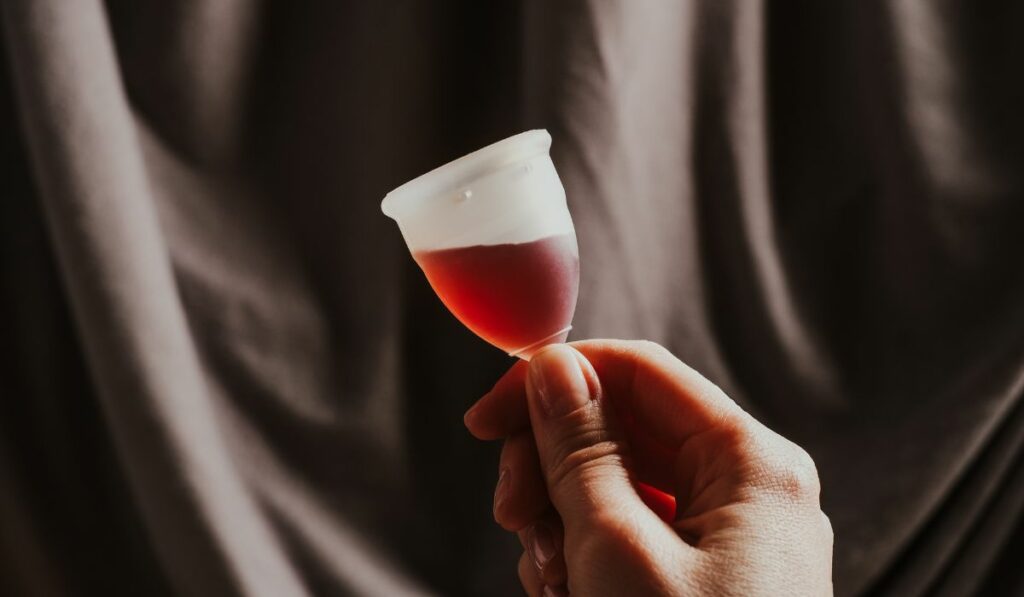
FAQs
What is the safest material for menstrual cups?
100% medical grade silicone is the safest non-toxic material for menstrual cups and discs. Although silicone allergy is extremely rare, keep in mind that it’s still possible to have an allergic reaction to anything, including silicone.
Are menstrual cups chemical-free?
Yes, menstrual cups that are made rom 100% medical grade silicone are free from toxic chemicals.
Do Diva cups have chemicals?
Diva cups are made from 100% medical grade silicone and are made with very minimal ingredients. Unlike period underwear (which can contain PFAS) and tampons and pads (which may contain dioxins and synthetic fragrances), Diva cups are free from toxic chemicals.
Is menstrual cup harmful or not?
As long as you use it as directed, menstrual cups are generally safe and carry very little risk. In fact, they can be even better at preventing infection and toxic shock syndrome when compared to tampons. Of course, if you have any negative reactions or special needs, be sure to talk to your gynecologist.
Do gynecologists recommend menstrual cups?
Most gynecologists have said that menstrual cup are perfectly safe for most people to use. If you have any questions about your individual needs, don’t be afraid to talk to your own gynecologist.


